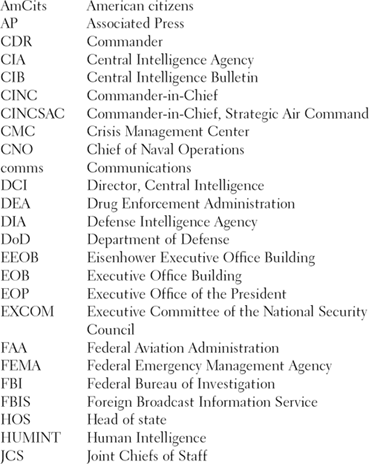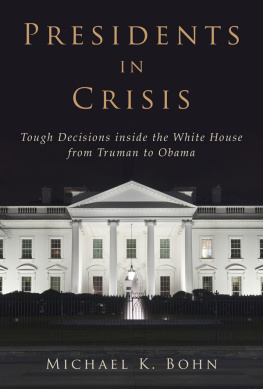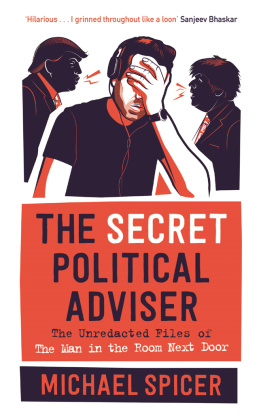NERVE CENTER
NERVE
CENTER
Inside the White House
Situation Room
MICHAEL K. BOHN

Copyright 2003 by Michael K. Bohn.
Potomac Books
Published in the United States by Inc. All rights reserved. No part of this book may be reproduced in any manner whatsoever without written permission from the publisher, except in the case of brief quotations embodied in critical articles and reviews.
Library of Congress Cataloging-in-Publication Data
Bohn, Michael K.
Nerve center : inside the White House Situation Room / Michael K.
Bohn.1st ed.
p. cm.
Includes bibliographical references and index.
1. United States. White House Situation Room. 2. PresidentsUnited
StatesStaff. 3. National securityUnited States. I. Title.
JK552 .B64 2003
973.92dc21 2002014962
ISBN 978-1-57488-438-8 (alk. paper)
Printed in the United States of America on acid-free paper that meets the American National Standards Institute Z39-48 Standard.
Potomac Books, Inc.
22841 Quicksilver Drive
Dulles, Virginia 20166
First Edition
10 9 8 7 6 5 4 3 2 1
To the men and women
of the
White House Situation Room
CONTENTS
ACRONYMS



PREFACE
As I scheduled interviews for this book, I decided to leave Dr. Condoleezza Rice, President George W. Bushs national security adviser, and her staff for last. Like all Americans, I did not anticipate the terrorist attacks of September 11, 2001. With America at war against terrorism, Dr. Rice and her staff did not have time to speak with me. I am told, however, the Situation Room has carried on, as they have under every other national crisis since 1961.
I wish to thank Sandy Doyle for her assistance in transforming an idea into a book and Rick Russell at Brasseys for his continuing assistance and encouragement. I am indebted to John Poindexter for his patient tutoring on future technologies that might influence the Situation Room, as well as for his imaginative ideas. Johns Project Genoa at the Defense Advanced Research Projects Agency helped me think about the future Situation Room. Thanks also go to Tony Lake for his interest and help.
I am grateful to the many people at several presidential libraries administered by the National Archives and Records Administration: Jim Hall at the Kennedy Library, Regina Greenwell and Phil Scott at the Johnson Library, Nancy Mirshah at the Ford Library, Polly Nodine at the Carter Library, Steve Branch at the Reagan Library, and Mary Finch at the George Bush Library. Thanks are also due Kate Henderson at the Smithsonian Institute, Laura Sharp and Katherine Lambert at Warner Bros., Kelli Grant at Newsweek, and Wally Mc-Namee for help with photographs.
In addition, I wish to acknowledge the Enright family Angela, Michael, and Seanfor their help in identifying the contribution made by Chuck Enright to the Situation Room. Special thanks go to Joy Dell McCabe for her memories of Gerry McCabe.
To all of the people who took the time to talk to me about their experiences in the Situation Room, I send my thanks, especially to David McManis, Dennis Chapman, Jim Fazio, Neil OLeary, Paul LeBras, Kevin Cosgriff, and Elliot Powell, all former directors of the Situation Room. Thanks also to my wife, Elin, for all her moral support and to Allen Benn and Steve Pickard for appearing to be interested in the books progress during our weekly golf game.
Finally, and I speak for everyone who worked in the Situation Room during the Reagan and Bush administrations, thanks to former President George H. W. Bush for being such a caring and thoughtful person.
PROLOGUE
Gayle, its the SDO in the Situation Room. Weve had two embassy bombings in Africa.
Gayle Smith, the senior director for African Affairs at the National Security Council, was used to being awakened at all hours by duty officers at the White House Situation Room, the Presidents intelligence and alert center. War in Rwanda, peace negotiations in Eritrea, and problems in Uganda had often kept her from a good nights sleep during the last three years of President Bill Clintons administration. But this sounded bad. Her clock read 3:45 A.M.
Im awake, Smith said. What do you know so far?
There have been explosions at our embassies in Kenya and Tanzania. State has no direct communications with the embassies; however, they have cell phone contact with people at each site. We have no information about casualties or the scope of damage, but CNN is trying to get cameras on the scene ASAP. We have called Dick Clarke, Sandy, Leon Fuerth, and Jim Steinberg. Anyone else?
No, thats the right list, said Smith. Clarke was the Presidents point man on terrorism on the National Security Council (NSC) staff, and these explosions were probably just that. Sandy was Samuel R. Sandy Berger, the Presidents national security adviser; both Smith and Clarke worked for Berger. Fuerth was Vice President Al Gores national security adviser and Steinberg was Bergers deputy. Smith expected Berger to notify the President immediately.
I will be there in an hour, Smith said, knowing full well that the Situation Room duty officers were already making calls to the State Department, the Central Intelligence Agency (CIA), and any other agency that might have further information about the blasts.
Berger indeed did call President Clinton in the predawn hours of August 7, 1998. As the rest of America awoke that summer day, the morning TV news shows carried video highlights of the destruction wrought by huge bombs at the U.S. embassies in Nairobi, Kenya, and Dar es Salaam, Tanzania. The explosions killed 257 people that day, including 12 American citizens, and injured 5,000.
In retrospect, the 1998 embassy bombings seem less significant when compared with the tragedies of September 11, 2001. Yet the events in Africa provided a window into the workings of the Situation Room during a crisis. The Situation Rooms phone call to Gayle Smith started a whirlwind of activity at the White House that lasted for more than two weeks and stretched the Situation Room to its operational limits. Further, overlaid on this severe drain on the Presidents energy was the suffocating scandal involving Clinton and a young White House intern named Monica Lewinski.
Gayle Smith arrived at the White House at 5:30 A.M. and immediately asked the Situation Room duty officers to set up a secure video teleconference between the White House and key operations centers in town. She wanted to exchange information with CIA, the Federal Bureau of Investigation (FBI), Department of State, and the National Military Command Center (NMCC) at the Pentagon. She also wanted to start the coordination of search and rescue operations and initiate both survivor assistance plans and criminal investigations. Situation Room Director Kevin Cosgriff called in off-duty Situation Room personnel not only to help Smith, but also to screen incoming information, draft reports for the President and his staff, and coordinate hundreds of phone calls.











